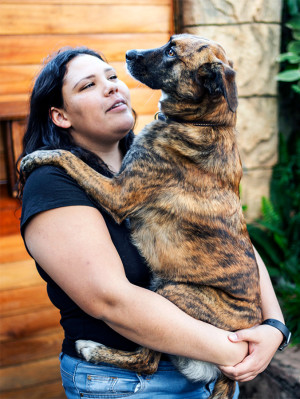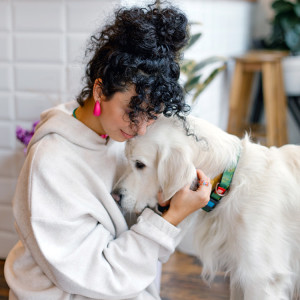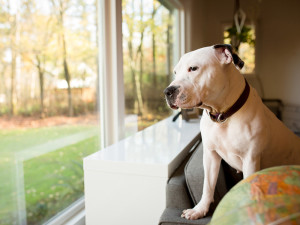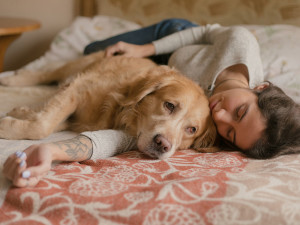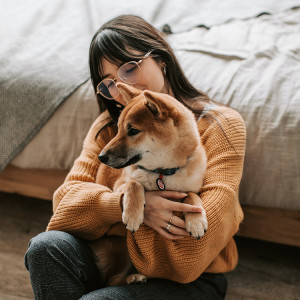Do Dogs Experience Anxiety?
No one—especially your pup—likes that uneasy feeling.

Share Article
In This Article:
What Is Dog Anxiety? Dog Separation Anxiety Fear-Related Anxiety Age-Related Anxiety
Dogs are so expressive and full of emotion, which is why we connect with them on such a deep level, and why many dogs will experience anxiety at some point in their lives. When you see your dog with a furrowed brow, shaking, or whimpering, it’s easy to relate to how they’re feeling and interpret that as anxiety.
Other times, dogs display anxiety in ways that are more subtle and these signs may be confused with other physical or behavioral concerns. The good news is that there are lots of effective ways to help ease your pup’s anxiety.
What is dog anxiety?
Anxiety is a reaction to an anticipated threat that has not actually happened. It can result in both behavioral and physical changes that are commonly referred to as the body’s “fight or flight response.” In dogs, this includes changes in their body language like lip-licking, panting, whining, tucking their tail, pulling their ears back, shaking, hiding, barking, growling, or avoiding eye contact. It can also involve physical changes, like dilated pupils, tense muscles, an increased heart rate, urinating, or defecating.

These same changes are seen in situations when dogs are experiencing fear. The difference is that fear implies there is an active threat while anxiety is based on a future event that they expect to encounter. The flight-or-fight response is adaptive, meaning it has beneficial effects in the right setting. When there really is a clear and present threat, dogs need to protect themselves by running away or fighting back.
The physical changes that occur during this response help a dog to focus, run faster, and get a boost of energy to protect themselves. The trouble is that this response is not adaptive when the threat is the vacuum cleaner, or simply you leaving the house to get the mail. When a dog’s fear or anxiety is working overtime and in settings that are not actually threatening, it can be problematic. Dogs displaying these signs are distressed, and they don’t feel safe or happy. They may also make you stressed out by creating situations that are destructive or unsafe. For both your dog’s sake and your own peace of mind, it is very important to help them overcome their fears and anxieties. This involves first characterizing their fear or anxiety and learning what triggers it. There are many different underlying reasons for a dog’s behavior, and targeting your treatment to the right one is crucial.
Dog separation anxiety
Separation anxiety is one of the most common forms of fear and anxiety seen in dogs and may affect up to 50 percent of dogs. Separation anxiety is an umbrella term for a collection of signs and behaviors in dogs, and it can have many different motivations.
Some common signs of separation anxiety are dogs who are like Velcro with their humans, never leaving their sides and following them from room to room. When they see their pet parents preparing to leave —picking up on cues like putting on a coat or picking up their car keys — dogs may start to whimper, pace, lick their lips, or show other signs of distress.
Once they are alone, they may bark or howl incessantly, scratch at the door, chew up furniture or clothing, or pee and poop inside. This is associated with a fear that their favorite person is never coming back. These behaviors are often compounded by other challenges they are facing including boredom or frustration.
Anxiety due to specific fears
Sometimes, the line between anxiety and fear is blurred, as is often the case with specific phobias. A phobia is a fear of something they perceive as a threat, leading to that whole fight-or-flight response. Some dogs may also have anxiety beforehand if they suspect they will be exposed to their phobia. For example, dogs that get anxious on every car ride because they predict they are going to the vet.
Some of the most common phobias in dogs are noise-related phobias like vacuum cleaners, hair dryers, or loud vehicles. Storm, thunder, and firework phobias are also very common in dogs. Dogs who are under-socialized may also be afraid of small children, strangers, or even other dogs if they do not know how to properly interact. They may show signs of fear in new situations or with unfamiliar objects. This can lead to a range of behaviors including hiding, running away, growling, barking, or even acts of aggression when they feel threatened.
Age-related anxiety
Dogs can show mental and behavioral changes related to old age that lead to anxiety, just like humans. Cognitive dysfunction is the term used in dogs when they show signs mimicking dementia. This includes pacing and whining, especially at night, getting stuck in corners or behind doors, confusion, forgetting cues they were trained on previously, or having accidents in the house. Old age can also be associated with increased anxiety due to certain physical changes.
Senior dogs may have decreased vision or hearing, which can make them feel less certain about their surroundings. They may have more trouble keeping tabs on where their favorite human is or be caught off guard by sights and sounds. They may also have pain related to chronic conditions, like arthritis, which make them anxious about being handled or playing rough with other dogs.
When to seek expert help
If you notice sudden behavioral changes in your dog, especially if there are also physical changes, like shaking, accidents in the house, or panting, it is important to see a vet right away. Medical conditions can also lead to behavioral changes, including increased anxiety and signs related to pain. It is important to rule out a medical cause first. Your vet can also be a helpful resource in treating anxiety. Most of the time, a multimodal approach is the best way to improve a dog’s anxiety.
This means using lots of different tools including exercise, behavior modification, training, enrichment, and medication to bring them maximum relief. A veterinary behaviorist or trainer can help you create a behavior modification plan as well. Some pet parents have a tendency to downplay behavioral problems like anxiety in their pets and presume that they can manage them on their own. However, it is important to recognize that managing a dog’s anxiety, especially when it leads to destructive or aggressive behaviors can be extremely distressing to pet parents and take a toll on their own mental health. Seeking professional help can make a big difference in your relationship with your dog and avoid more serious consequences like having to rehome your dog or incur large expenses if your dog damages your home. Don’t be afraid to ask for help.
Bottom line
Anxiety is common in dogs and may be related to specific situations or experiences.
Treatment will be most effective once you identify the type of anxiety your dog has and their particular triggers.
It is always a good idea to seek professional help in treating your dog’s anxiety in order to rule out underlying medical causes and learn the most effective treatment options.
References
Anxious behavior: How to help your dog cope with unsettling situations.opens in new tab Cornell Richard P. Riney Canine Health Center.
De Assis, Luciana, et al. “Developing Diagnostic Frameworks in Veterinary Behavioral Medicine: Disambiguating Separation Related Problems in Dogsopens in new tab.” Frontiers in Veterinary Science, 16 January 2020, vol. 6.
Dewey, CW, et al. “Canine Cognitive Dysfunction: Pathophysiology, Diagnosis, and Treatmentopens in new tab.” Veterinary Clinics of North America: Small Animal Practice, vol. 49, no. 3, May 2019, pp. 477-499.
Edwards, Petra et al. “Investigating risk factors that predict a dog’s fear during veterinary consultationsopens in new tab.” PLoS One, 22 June 2019, vol. 14, no. 7, e0215416.

Dr. Amy Fox, DVM
Amy Fox, DVM is a small animal veterinarian in New York City with over thirteen years of experience in a mixture of general practice, emergency medicine, and shelter medicine. A lifelong animal lover, Dr. Fox studied biology in college and then worked as a veterinary nurse before pursuing veterinary school at Cornell University. Her expertise includes surgery, dentistry, and management of chronic conditions, and she is interested in toxicology, pain management, nutrition, care of senior pets, and educational outreach. Dr. Fox also enjoys writing about veterinary medicine and teaching, and her work has previously appeared in Spruce Pets. In her free time, she loves to cook, garden, go for long runs, and hang out with her goofy mixed-breed dog May, who provides never ending comic relief!
Related articles
![woman comforts her dog]()
What Medication Can You Give Your Dog for Anxiety?
Here are some options your vet can help you consider.
![Muscular white pit bull stands on couch, looking out window to sunny fall day.]()
Separation Anxiety in Dogs
Does your dog freak out when you head for the door? Here’s some advice.
Does Your Dog Need Anti-Anxiety Meds?
How to cope with dog anxiety—from training to medication.
![Pet parent comforting anxious dog by holding their paw]()
How to Help an Anxious Dog
Easy ways to calm your pup’s nerves.
![A woman wearing a knit sweater holding a dog close on the floor of her bedroom.]()
Separation Anxiety in Dogs
Train your dog to stay calm when they’re on their own — instead of sad-singing “All By Myself” until you come home.
Can You Have a Service Dog for Anxiety?
Definitely something worth looking into.

